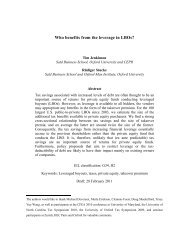Corporate Social Responsibility in India - Said Business School
Corporate Social Responsibility in India - Said Business School
Corporate Social Responsibility in India - Said Business School
You also want an ePaper? Increase the reach of your titles
YUMPU automatically turns print PDFs into web optimized ePapers that Google loves.
to improve it. It is often the case that CSR<br />
programs emerge out of the founders'<br />
desires to create alternatives which<br />
challenge exist<strong>in</strong>g models, and their<br />
corporate practices are shaped by their<br />
underly<strong>in</strong>g deontological views about social<br />
reality. The motivation for socially<br />
responsible activities of companies often<br />
comes from the leadership and orientation<br />
of top management (Sood and Arora 2006).<br />
Alternatives to exist<strong>in</strong>g order can be put<br />
<strong>in</strong>to three categories: alternatives to the<br />
state, alternative community and<br />
alternatives to the market.(Schwabenland<br />
2006) In <strong>India</strong>, alternatives to the state and<br />
alternative community seem to be<br />
prevail<strong>in</strong>g, while market alternatives are<br />
less noticeable.<br />
1) Alternatives to the state<br />
There has been a global trend toward<br />
greater <strong>in</strong>volvement of the private sector <strong>in</strong><br />
the division of responsibility between the<br />
state and the private sector for the delivery<br />
of public goods and services. The <strong>India</strong>n<br />
government faces many challenges <strong>in</strong><br />
address<strong>in</strong>g the immense problem of poverty<br />
<strong>in</strong> the country. The public sector has<br />
partnered with the private sector <strong>in</strong> <strong>India</strong><br />
for sometime now. The real shift, however,<br />
took place <strong>in</strong> the 1990s when <strong>India</strong><br />
4<br />
liberalized its economy, an event brought<br />
about by a prolonged national f<strong>in</strong>ancial<br />
crisis. The private sector was allowed to<br />
operate <strong>in</strong> many areas that had been<br />
previously reserved for the public sector,<br />
and was given more opportunities to<br />
compete <strong>in</strong> more segments of the economy<br />
(GBC 2007).<br />
The performance and activities of the public<br />
sector on welfare has not always escaped<br />
criticisms from <strong>in</strong>dustrialists <strong>in</strong> <strong>India</strong>.<br />
Industry leaders <strong>in</strong> <strong>India</strong> have repeatedly<br />
blamed the government’s poor performance<br />
<strong>in</strong> education for the dearth of qualified<br />
candidates and the ‘poor quality’ of most<br />
eng<strong>in</strong>eer<strong>in</strong>g graduates, and argued that<br />
steps should be taken to make young<br />
people from rural areas and lower castes<br />
more competitive <strong>in</strong> the job market,<br />
especially by improv<strong>in</strong>g the quality of school<br />
education.<br />
The IT <strong>in</strong>dustry has taken steps to upgrade<br />
and re-orient eng<strong>in</strong>eer<strong>in</strong>g education to<br />
better suit its needs <strong>in</strong> the form of<br />
corporate social responsibility. At the CII<br />
National Summit on CSR 2007 Mr Venu<br />
Sr<strong>in</strong>ivasan, Chairman, <strong>in</strong> his address said<br />
that the benefits of the Government’s<br />
welfare schemes did not always reach the<br />
target groups. Industrial experience could
















